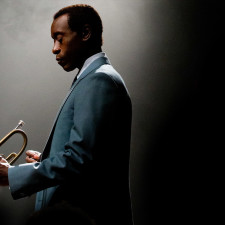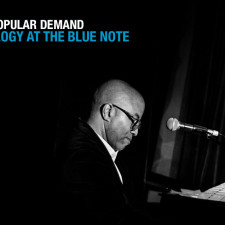Jason Moran and the Bandwagon, Village Vanguard, New York, October 5, 2010
The first set of Jason Moran’s trio weeklong engagement was packed and buzzed with anticipation. The legendary Village Vanguard, one of the great places to hear powerful jazz in an acoustically compressed environment, was an ideal setting for the sound party. You could see something extra in crowd’s faces as well as on Moran himself as he warmly greeted fans, friends, and family before he and his bandwagon tore up the joint with no apologies or explanation.
Moran, a newly minted and quite deserving recipient of a MacArthur genius award had much to celebrate that evening. The grant, a $500, 000 gift from the John D. and Catherine T. MacArthur Foundation, changes lives allowing artistic recipients to concentrate more on the art of the matter and less on the hustle that is an unavoidable part of their existence. One of the many takeaways for students in my annual history of jazz course is the understanding of how much great music can be born of economic hardship and exploitation. In this case, the genius grant interrupts that standard narrative and begs another question: how much and what quality of art can be created with ample support? We got a glimpse of that future last night.
Genius is such a slippery concept. It’s a label that gets tossed around musical circles usually to describe an artist with a highly visible and prolific content. We also use it to talk about people with an unusually profound endowment of technical facility through which they express something that audiences perceive as “universal,” “timeless,” or transcending the moment in which they experience them. Musical genius, however, is always in the ears, hearts, and heads of the beholder. Experiencing something called genius, for me, is not a matter of transcendence necessarily: it is, rather, the profound ability to—through one’s mechanics of musical delivery—anchor listeners in a deep sense of a “present tense.” And genius, despite its reputation, is never a matter of isolated, rugged individualism. As the Bandwagon demonstrates, it can also be a collaborative affair, one in which the band becomes a living model of thoughtful and meaningful social interaction, something that we are born to desire.
Bathed in bright stage lights and surrounded by a clutter of written scores, the Bandwagon moved up something serious through an adventurous set of compositions from past projects and their new CD, which was released earlier this year. They opened with a powerful reading of a song written by Alicia Hall Moran, Jason’s talented and very soprano spouse. “Blessing the Boats” was packed with sly ostinato figures in the piano, pushy pop musical gestures, and sinewy melodies winding through tricky harmonic environments. It was an exploration of composition in process that worked well, preparing us for the meal in the guise of a meaningful gracing of the table.
Three factors of the evening’s work stood out. The empathetic and telepathic virtuosity demonstrated among his colleagues drummer Nasheet Waits and bassist Tarus Mateen simply astounded. These very strong musical personalities are not simply a backdrop for Moran’s musings: they are part and parcel of the sonic mosaic that has become his vehicle in much the same way as Duke Ellington’s orchestra was for his. Moran’s compositional signature and improvisation rhetoric also leave a lasting impression long after the last strains were heard. I’ve seen this band on several occasions, and all three of these qualities were present and rewarding every time.
Throughout the set Moran’s performance rhetoric included full voiced gospel-style chords in the right hand with single note doublings with Mateen; Earl Hines’ “trumpet style”; Bud Powell-esque bebop lines; Cecil Taylor-like passages of dissonant, florid, pianism; and gutsy tremelo passages that sound like a vocalized field hollers straight out of the ring shout rituals of black expressive culture. His most intense solos move rapidly between arpeggios superimposed over dissonant harmonic structures and spirited scales. As Moran combines this rhetoric over the course of several songs, one experiences in real time a white-knuckled virtuosity awash in dizzying counterpoints of melodies, timbres, and polyrhythms that ebb and flow in apparent spontaneity.
His compositions are studies in the economic use of emotional momentum. Many move from precious, pithy statements into grand pronouncements and back again. Some leave you on the mountaintop, breathless. The Bandwagon achieves these in the context of grooves that while infectious, are not easily digested. That is, one has to concentrate to perceive the large structures of their form. They are not built on smallish cyclic harmonic patterns but on larger scale patterns of repetition. Moreover, because of their length, they can sound like seamless multi-movement jazz suites. Their grooves take on many rhythm configurations: from soupy, downhome blues, hard bop swing, or rhythm rhetoric from more contemporary soundworlds. Moran’s occasional use of onstage pre-recorded sounds give the effect of an installation art piece, where we in the audience are snapped out of our typical listening positions and drawn into a more intense listening and visual relationship with the band. A band, which by the way, seems to be experiencing the wonder of the thing along with us.
Guthrie Ramsey
Tags: genius, jason moran, Jazz, macarthur grant, village vanguard


 Share On Facebook
Share On Facebook Tweet It
Tweet It








![[Philly EVENT] Screening of Amazing: A Film about Bud Powell](http://musiqology.com/blog/wp-content/uploads/2015/03/bud-powell-225x225.jpg)



